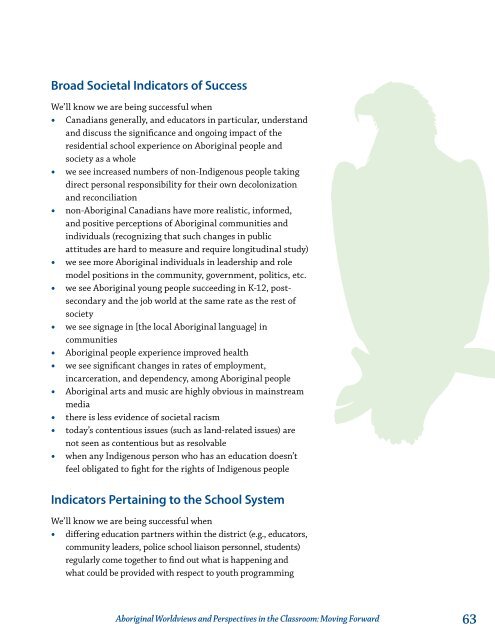Aboriginal Worldviews and Perspectives in the Classroom
Ab-Worldviews-and-the-Classroom-220mzng
Ab-Worldviews-and-the-Classroom-220mzng
Create successful ePaper yourself
Turn your PDF publications into a flip-book with our unique Google optimized e-Paper software.
Broad Societal Indicators of Success<br />
We’ll know we are be<strong>in</strong>g successful when<br />
••<br />
Canadians generally, <strong>and</strong> educators <strong>in</strong> particular, underst<strong>and</strong><br />
<strong>and</strong> discuss <strong>the</strong> significance <strong>and</strong> ongo<strong>in</strong>g impact of <strong>the</strong><br />
residential school experience on <strong>Aborig<strong>in</strong>al</strong> people <strong>and</strong><br />
society as a whole<br />
••<br />
we see <strong>in</strong>creased numbers of non-Indigenous people tak<strong>in</strong>g<br />
direct personal responsibility for <strong>the</strong>ir own decolonization<br />
<strong>and</strong> reconciliation<br />
••<br />
non-<strong>Aborig<strong>in</strong>al</strong> Canadians have more realistic, <strong>in</strong>formed,<br />
<strong>and</strong> positive perceptions of <strong>Aborig<strong>in</strong>al</strong> communities <strong>and</strong><br />
<strong>in</strong>dividuals (recogniz<strong>in</strong>g that such changes <strong>in</strong> public<br />
attitudes are hard to measure <strong>and</strong> require longitud<strong>in</strong>al study)<br />
••<br />
we see more <strong>Aborig<strong>in</strong>al</strong> <strong>in</strong>dividuals <strong>in</strong> leadership <strong>and</strong> role<br />
model positions <strong>in</strong> <strong>the</strong> community, government, politics, etc.<br />
••<br />
we see <strong>Aborig<strong>in</strong>al</strong> young people succeed<strong>in</strong>g <strong>in</strong> K-12, postsecondary<br />
<strong>and</strong> <strong>the</strong> job world at <strong>the</strong> same rate as <strong>the</strong> rest of<br />
society<br />
••<br />
we see signage <strong>in</strong> [<strong>the</strong> local <strong>Aborig<strong>in</strong>al</strong> language] <strong>in</strong><br />
communities<br />
••<br />
<strong>Aborig<strong>in</strong>al</strong> people experience improved health<br />
••<br />
we see significant changes <strong>in</strong> rates of employment,<br />
<strong>in</strong>carceration, <strong>and</strong> dependency, among <strong>Aborig<strong>in</strong>al</strong> people<br />
••<br />
<strong>Aborig<strong>in</strong>al</strong> arts <strong>and</strong> music are highly obvious <strong>in</strong> ma<strong>in</strong>stream<br />
media<br />
••<br />
<strong>the</strong>re is less evidence of societal racism<br />
••<br />
today’s contentious issues (such as l<strong>and</strong>-related issues) are<br />
not seen as contentious but as resolvable<br />
••<br />
when any Indigenous person who has an education doesn’t<br />
feel obligated to fight for <strong>the</strong> rights of Indigenous people<br />
Indicators Perta<strong>in</strong><strong>in</strong>g to <strong>the</strong> School System<br />
We’ll know we are be<strong>in</strong>g successful when<br />
••<br />
differ<strong>in</strong>g education partners with<strong>in</strong> <strong>the</strong> district (e.g., educators,<br />
community leaders, police school liaison personnel, students)<br />
regularly come toge<strong>the</strong>r to f<strong>in</strong>d out what is happen<strong>in</strong>g <strong>and</strong><br />
what could be provided with respect to youth programm<strong>in</strong>g<br />
<strong>Aborig<strong>in</strong>al</strong> <strong>Worldviews</strong> <strong>and</strong> <strong>Perspectives</strong> <strong>in</strong> <strong>the</strong> <strong>Classroom</strong>: Mov<strong>in</strong>g Forward<br />
63


